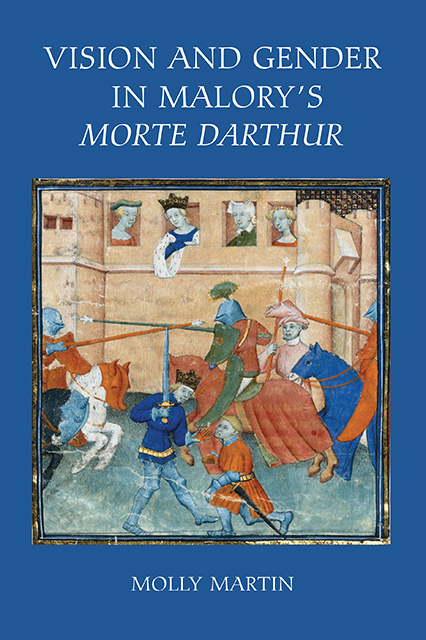Book contents
- Frontmatter
- Contents
- Acknowledgments
- Editorial Note
- Introduction: Masculinity and Vision in the Morte Darthur
- 1 “Beholdyng” Gareth: The Spectacle of Romance Masculinity
- 2 Gazing at the Queen: Trystram and Launcelot
- 3 Seeing Unseen: Palomydes and the Failure of Masculine Display
- 4 Romancing Religion: Competing Modes of Vision on the Grail Quest
- 5 The Female Gaze: Constructing Masculinity with and without Men
- Conclusion: Malory’s Arthurian Visions of Masculinity
- Bibliography
- Index
- Miscellaneous Endmatter
4 - Romancing Religion: Competing Modes of Vision on the Grail Quest
Published online by Cambridge University Press: 01 March 2023
- Frontmatter
- Contents
- Acknowledgments
- Editorial Note
- Introduction: Masculinity and Vision in the Morte Darthur
- 1 “Beholdyng” Gareth: The Spectacle of Romance Masculinity
- 2 Gazing at the Queen: Trystram and Launcelot
- 3 Seeing Unseen: Palomydes and the Failure of Masculine Display
- 4 Romancing Religion: Competing Modes of Vision on the Grail Quest
- 5 The Female Gaze: Constructing Masculinity with and without Men
- Conclusion: Malory’s Arthurian Visions of Masculinity
- Bibliography
- Index
- Miscellaneous Endmatter
Summary
The transition into “The Tale of the Sankgreal” marks a fairly abrupt shift in the Morte, as goals established for and by the Round Table knights, goals that are both individual and communal, become religiously motivated. These literal and figurative changes on the grail quest consequently effect a relocation of the methods of assessing the successes and failures of knights – or at least they should. However, modes of vision that governed the previous sections of the Morte continue to hold sway despite the disjunction that arises between them and the overtly Christian principles of the quest. The ways in which Gareth, Launcelot, and Trystram have negotiated their masculinity in the public eye do not become obsolete with the onset of the grail quest. While there is a clearly enunciated and often reiterated reconfiguration of the model of the ideal knight, the text persistently subscribes to the pre-established romance system of vision. Even with circumstances so markedly morphed onto the new religious landscape, the seemingly outdated assessment of male gender identity – through the use of projective visual images, of performances of masculinity – retains considerable weight as the knights maneuver on this new playing field. Even Galahad, who is the most exemplary of grail knights and who generally follows the more contextually appropriate Christian doctrine, is implicated in this romance visual model. Indeed romance visual models pervade Malory's “Sankgreal,” and thus invite a multipronged investigation. In the text's attention to the sight of the grail itself, in the character's visual perceptions, and in the continued necessity of visibility, the romance mode of vision remains the primary method of constructing and confirming masculinity. Despite the inherited story's apparent incompatibility with the established romance modes of vision, Malory minimizes the interrogation of these modes and bypasses opportunities to question their viability as gender markers.
That the “Sankgreal” depicts an Arthurian world very different than that pictured in the secular quests throughout the rest of the Morte has become something of a critical refrain.1 Although the degree to which this grail quest and its values differ and the exact nature of the discrepancies can and have been debated, certainly this tale introduces some change in tenor.
- Type
- Chapter
- Information
- Vision and Gender in Malory's Morte Darthur , pp. 118 - 147Publisher: Boydell & BrewerPrint publication year: 2010



